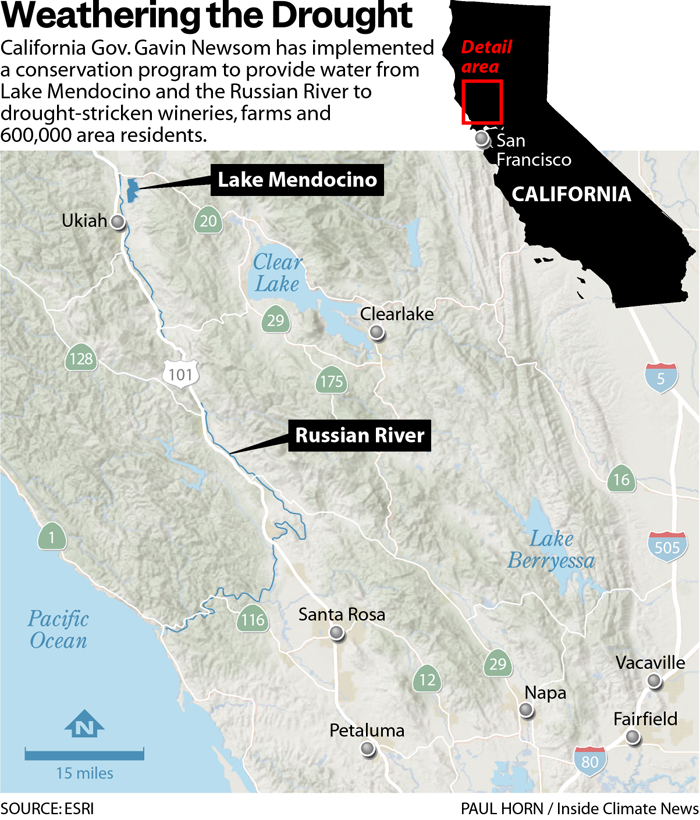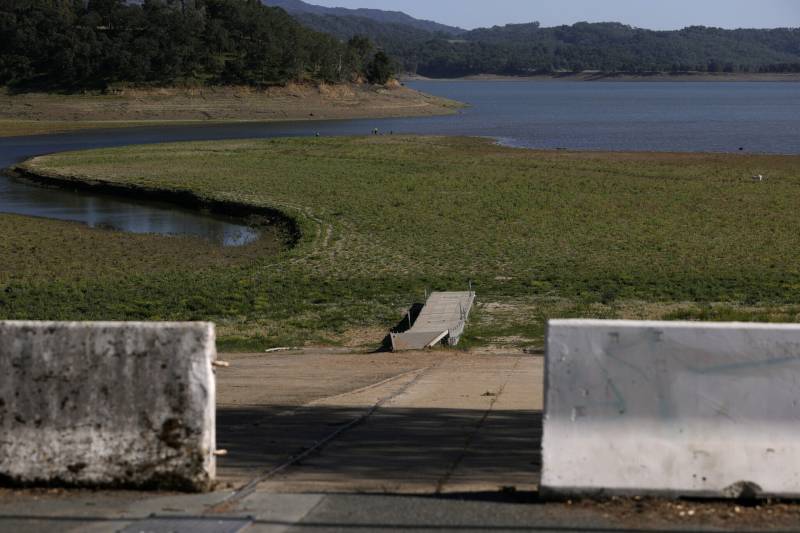California Gov. Gavin Newsom stood at a podium placed on the sandy bottom of Lake Mendocino, a basin built to hold more than 20 billion gallons of water. It was spring, which meant that the reservoir should have held water from the winter rains that in past decades provided water to millions of Californians. Instead, on this afternoon in 2021, the ground was dry and cracked. Newsom was there to declare a drought emergency.
“Climate change is intensifying both the frequency and the severity of dry periods,” he said. It was time for California to prepare for “what may be a prolonged drought at our doorstep.”
The state is contending with its driest three-year period on record. The lake reservoir where Newsom set his declaration supplies water to the Russian River, which in turn provides water for 600,000 people and to some of California’s best-known wineries. Now, the watershed and the reservoir where this drought began have become the proving ground for an innovative water agreement that aims to make more of scarce supplies. Creators say the program could become a prototype for accords elsewhere in the state and in the West, a beacon of collaboration in a place where water can be contentious.
Working through the state’s convoluted water rights system, the novel agreement inked this summer allows water users to voluntarily conserve. The water left over can be passed on to other users in the area who have less priority and who, without the program, may have been left with nothing. Very generally, in a normal year, users with older water rights are allowed first priority, and in times of shortage, junior users are the first to be cut back.
This year, the project ran for about four weeks of the growing season, an abbreviated test run that allowed some grape growers to keep plants alive after years of scrimping.
“Even if it was for only a few more weeks than the previous year, for a farmer, particularly, that can be make or break,” said Elizabeth Salomone, general manager of the Russian River Flood Control and Water Conservation Improvement District, which has contracts to disburse water from Lake Mendocino and the Russian River to farmers and water suppliers.
An order to reduce flows further upstream shut the program down early, but the agreement’s architects hope to keep it ready to run again next year as they plan for the potential of another dry winter in California.
After privation, working together
A few months after Newsom stood at the bottom of Lake Mendocino, water rights attorney Philip Williams recalls sitting in his law office, surrounded by a portrait of Abraham Lincoln and framed paintings commemorating his time serving in the Army. He was logged onto a state court website, ready to sue California.
“My finger was on the trigger,” he said.

In May 2021, the state board that controls California water rights warned that Lake Mendocino was at a critically low level. Later in the summer, to prevent the reservoir from running dry, the state ordered thousands of users to stop diverting water from several rivers, a policy known as curtailment. The state even cut the rights for Ukiah, a town of about 20,000 in rural wine country with senior water rights that is one of Williams’ clients.
The attorney thought the restrictions were wrong. Ukiah, which had access to recycled water and groundwater, wasn’t in danger of running out of supplies. But the town wanted to help other communities that didn’t have the same backup. The disagreement took Williams to the brink of legal action.
Though a lawyer by trade, litigation wasn’t Williams’ preferred remedy. A veteran who served in Iraq, Williams felt the war was an institutional failure. Though his tour was decades ago, taking the state to court felt similar to him — parties have long sued over water, yet the fights over water supplies continued. He thought there was a better path.
“This program is a way to show that we can get out of that cycle,” he said.
According to Salomone, the state water board had floated the potential for alternatives to curtailment back in 2020, suggesting in a meeting with water providers and users in the Russian River watershed that they devise some type of sharing program for constrained supplies.
In California, those types of agreements are exceedingly rare. A complex rights system governs water, designating who can pull from underground supplies, rivers and state-run reservoirs and canals at certain times. Williams also remembers the board raising the idea, on a call he took while driving. Others on the call met the proposal with silence, which he read as surprise. Water supplies reached severe lows before any such agreement could be hatched, and then came the curtailments in 2021.
Ukiah was far from the only user upset by the policy, which affected thousands of rights holders, including municipalities and farms. In Redwood Valley, a community north of Ukiah that purchases most of its water, residents were each limited to 55 gallons per day, an amount the state sets for human health and safety needs. Some reported showering with rainwater collected from their roofs. Ukiah trucked water to the coast, where restaurants could only serve water on request.
When users in the watershed got together in the fall to discuss solutions, the pain of those cuts and earlier ones remained fresh.
“There was still a lot of bruising among the community,” said Salomone, who attended the meetings and helped coordinate the agreement. “So it took us a while to get the ball rolling.”
The state hired a facilitator to help water users work together. Over the next several months, state regulators, water users, suppliers, tribes and city representatives including Williams met once a week, with many members gathering even more frequently in smaller groups. After months of negotiations, they unveiled a voluntary sharing agreement designed to avoid the cuts many of them had just experienced. Users signed up, agreed to conserve a certain amount based on previous usage and shared the extra water with more junior users.
Water users accounting for about 42% of the watershed’s demand participated, which felt like a success to the organizers of an unproven program. Contributors like Salomone see it as a way to bend the inflexibility of California water law to modern conditions influenced by climate change.
“It does provide a creative mentality of looking at solutions that are locally driven and collaborative,” said Devon Jones, executive director at the Mendocino County Farm Bureau, a grower membership organization where Jones estimates about three-quarters of the work is water-related. “That in itself is an improvement.”
Appreciating a bit of leeway as supplies dry up
California gets three-quarters of its precipitation in the months between November and March. Some of that falls as snow, which melts and eventually runs from the mountains down to the ocean. But in recent years, winters have been dry.
On the cusp of December this year, Lake Mendocino looked about as empty as it did in April 2021 when Newsom made his announcement. Residents walked their dogs on the reservoir’s floor, and craggy rocks marked a historic shoreline yards above the lake’s exposed bottom. Part of the reason the basin is so dry is because of a lack of rain. Climate change is making precipitation patterns in California more erratic, increasing temperatures and melting snow earlier, which makes the state drier.
With precipitation growing more inconsistent, users have had to look to other supplies.
In Ukiah, where Lake Mendocino is located, concrete basins on the edge of town can hold up to 66 million gallons of recycled water, enough to supply roughly 30% of the city’s annual use and to provide nitrogen-rich water to nearby farms. Ukiah spent $34 million to build the facility, which came online in 2019. At the end of August, the basins that hold the recycled stores were completely empty, said Sean White, Ukiah’s director of water and sewer resources.
Jackson Family Wines, one of the largest wine companies in the U.S., is recycling water, too. The company, which has vineyards across California, Oregon and abroad, now reuses water for washing wine barrels. In lean years, growers will also lop off weaker grape clusters to leave resources for more promising ones, or water just enough to keep vines alive.
Other users rely on groundwater. The Dry Creek Rancheria Band of Pomo Indians, which owns sovereign land south of Ukiah and grows grapes on nearby vineyards, muscled through the last few years of drought using only wells. Though it supports the water sharing agreement, the Tribe didn’t sign on because it had sufficient water for its needs this year, said Christopher Ott, the Tribe’s environmental director. The Tribe will consider participating in future years if the program continues.
When the sharing program began in July, it offered greater water supply for participants. Big wineries like Sutter Home and Gallo and cities including Ukiah and Healdsburg joined.
Participants said the program offered a bit of leeway amid more state water curtailments. In 2021, for example, Healdsburg was forced to stop nearly all irrigation. This year, the agreement allowed the city 10% to 20% more water, according to Terry Crowley, the city’s utilities director.
Carolyn Wasem, senior vice president for government relations and external affairs at Jackson Family Wines, said the company was able to extend its growing weeks when water was available. “We had one more month of water or two more months of water than we would have had otherwise,” she said.
“Which to me was the ultimate goal,” said Susanne Zechiel, the company’s vice president for environmental regulatory compliance.
But the agreement functioned for just a few weeks before it hit a snag: a federal commission ordered a reduction in water flows through a hydroelectric project and into Lake Mendocino. The reduced flows lowered the amount of water available to downstream users participating in the agreement. In August, the state put the program on indefinite hiatus and told participants that many of them would have to adhere to the very cuts they had tried to avoid.
The order was intended to protect water storage levels and habitat for fish. But for many associated with the water sharing agreement, the change in flows was a frustrating wrinkle in an already complex process. It’s unclear when and if flows will increase.
Barring any change in California’s drought emergency, the agreement officially ends at the end of the year.
The collaboration was nothing short of remarkable, said Sam Boland-Brien, a program manager at the state water board who helped set it in motion, and it could help other areas dealing with scarce water — even within restrictive water rights systems — to look at sharing. In Nevada, a recent Supreme Court ruling green-lighted a plan in which farmers and ranchers will work to reduce use and can trade the water left over.
In California, many expect the program to get a second shot next year. Its creators are working on a report to the state about how to improve the agreement for 2023.
“Everybody looked at each other and said, ‘I’m better off with you than without you, and the only way we’re all going to get through the drought is if we work together and we share,” said Laurel Marcus, who helped develop the agreement and operates a certification program called Fish Friendly Farming in nine California counties. “I don’t know how many places that can happen, but I bet a lot of the rural West can do that.”
Inside Climate News is a nonprofit, independent news organization that covers climate, energy and the environment. Sign up for the ICN newsletter here.

